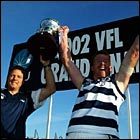|
Welcome
to the Ablett Gallery - a pictorial tribute to
the greatest player of the greatest
game for
the greatest team and to the Geelong Football Club. Scroll down for a
short history of the Cats.
|
Gary
Ablett
Born: October 1,
1961
Height: 185cm.
Playing
weight: 90kg.
VFL debut: 1982
(Hawthorn)
|
|
|
|
Visit Molly's
For Books, Cards, and Videos Featuring Gazza and the Cats!.
|
|
Gazza played
248 games for Geelong from 1984-96, kicking 1030 goals. He
played as a wingman for Hawthorn before moving to Myrtleford where the
Cats swooped. Ablett
was a Norm Smith and Coleman Medallist and a Geelong Co-Captain in
1995-96. Gary
Ablett Junior was snapped up in the 2001 draft as a seventeen year old
and has shown a great amount of promise in his debut season. Gary
has another son, Nathan. He is sixteen, 191cm and playing with Modewarre
in the Geelong league.
More
Stats on Gary Senior
Geelong Football Club
|
Entered VFL/AFL: 1897
Home Ground: Skilled Stadium
(Kardinia Park), Geelong.
Address: La Trobe
Tce., Geelong
Postal Address: P.O Box 461, GEELONG 3220
COLOURS: GUERNSEY: Navy Blue and White hoops
SOCKS: Navy Blue and White hoops
SHORTS: Home: Navy Blue; Away: White
Premierships: 6 - 1925, 1931, 1936,1951-52,1963
Recent Grand
Finals: 1989 (Hawthorn) - 1992 (West Coast) - 1994 (West Coast) - 1995
(Carlton).
Brownlows: 4 -
E. 'Carjie'Greeves -1924, Bernie Smith -1951, Alistair Lord -1962, Paul
Couch -1989
GROUND CAPACITY - 2002: 28,000
RECORD HOME ATTENDANCE: 49,109 August 20, 1952 V
Carlton
GAMES RECORD HOLDER: Ian Nankervis - 325
CLUB'S GREATEST GOAL KICKER:
Gary Ablett - 1021
A SHORT HISTORY
Geelong has worn the
blue and white hoops since 1896. Prior to this, there were several variations of
uniform and before 1873 no-one had even thought of uniforms of grouping colours.
Geelong is one of
the leagues oldest clubs having helped co-found the league in 1897.
During the
formative years, Geelong was known variously as the Seagulls, Pivotonians
and Black Cats, from which the present day Cats have evolved.
The AFL's
highest honour, the Brownlow Medal, is named after Charles Browlow, a
former Geelong secretary.
A tireless
administrator, Brownlow was associated with the club for about 40 years.
He was a
player in the early days and captained the side when it won the VFA
premiership (the VFA operated between 1870 and 1897 when the VFL was
formed following a breakaway).
Along with that
claim to fame, Mr Tom W. Wills, of Geelong, is regarded by some as being the
founder of the game itself.
That form of
the game started in Geelong in 1856 with the club formed three years
later in 1859.
Geelong is
now known throughout Australia, and the world, for its football team.
The first
premiership in the newly formed competition came in 1925, the first year
with the twelve VFL clubs.
In the
1930's, the big names at Cat Land included Reg Hickey, George
Maloney, 'Jacka' Todd, Jack Collins and 'Carjie' Greeves (below), the
club's first Brownlow Medalist.
Hickey
was a member of the 1931 premiership side, captain-coach of the
1937 team and non-playing coach of the successful 1951 and '52
combinations.
Geelong's
home at Kardinia Park was established in 1940 after the original base at
Corio Oval was taken over by the military as part of World War 2 effort.
War-time
restrictions also forced another change for the Cats - the club was
unable to field a team in the VFL during 1942 and '43 but bounced
back in 1944.
The Cats
returned to football after the war and was appointed coach in 1949.
The
most successful period for the club was the early 1950's when they
won two premierships and were beaten in another Grand Final.
1951 is
remembered as a particularly successful season with the Cats winning the
flag, Bernie Smith winning the Brownlow for a second time in a row and another Geelong player
taking out the goal-kicking.
Geelong won
the flag again in 1952 and it was obvious that the club was in the midst
of one of it's greatest era's.
They
were the days when the Wily Reg Hickey coached big names such as
Bernie Smith, Fred Flanigan, Bob Davis, Peter Pianto and Bruce
Morrison.
The
Cats won 23 games on end in 1951-52, a record which still stands.
The
50's also saw a fantastic administration led by A.R
"Jack" Jennings.
During his
30-year association with the club, he served a record 26-years as
president and four years as committeeman.
The Cats
made the final four in every year between 1959 and 1956 but inexplicably
dropped to wooden spooners in 1957.
Then
came former flying winger, Bob Davis to coach and with him came the
1963 premiership.
Davis was in
charge of stars who included Fred Wooler, Polly
Farmer, Bill
Goggin and John Sharrock.
The Cats
made the grand final again in 1967 but were beaten by Richmond.
Then
came the late eighties to the mid-nineties. We had a truck-load of
supremely skilled footballers including Gary
Ablett, Garry
Hocking, Mark
Bairstow, Brownlow medalist Paul
Couch, Ken
Hinkley and Bruce Lindner (below).
We also had a coach in Mal Blight
who fitted in a the club like a hand in a glove. Freakishly
skilled and flamboyant as a player, enigmatic and cutting-edge
coach he and the great players who wore the hoops under him,
embodied what following Geelong is all about.
Between
1989 and 1995 we lost four Grand Finals. This will only make
impending success that much sweeter for supporters of the leagues
founding club.
And
success does look imminent.
Bomber
Thompson and the team are doing us proud. They have a real go and
seem to learn quickly from their mistakes. They are also extremely
talented footballers. Lets hope we can hold on to these young
blokes and the coach and that the roller coaster ride is almost
over.

Go to our links
page to join the GFC from the Official Cats Site!
GO TO OUR GREAT
CATS PAGE FOR OUR BEST ALL-TIME PLAYERS

|